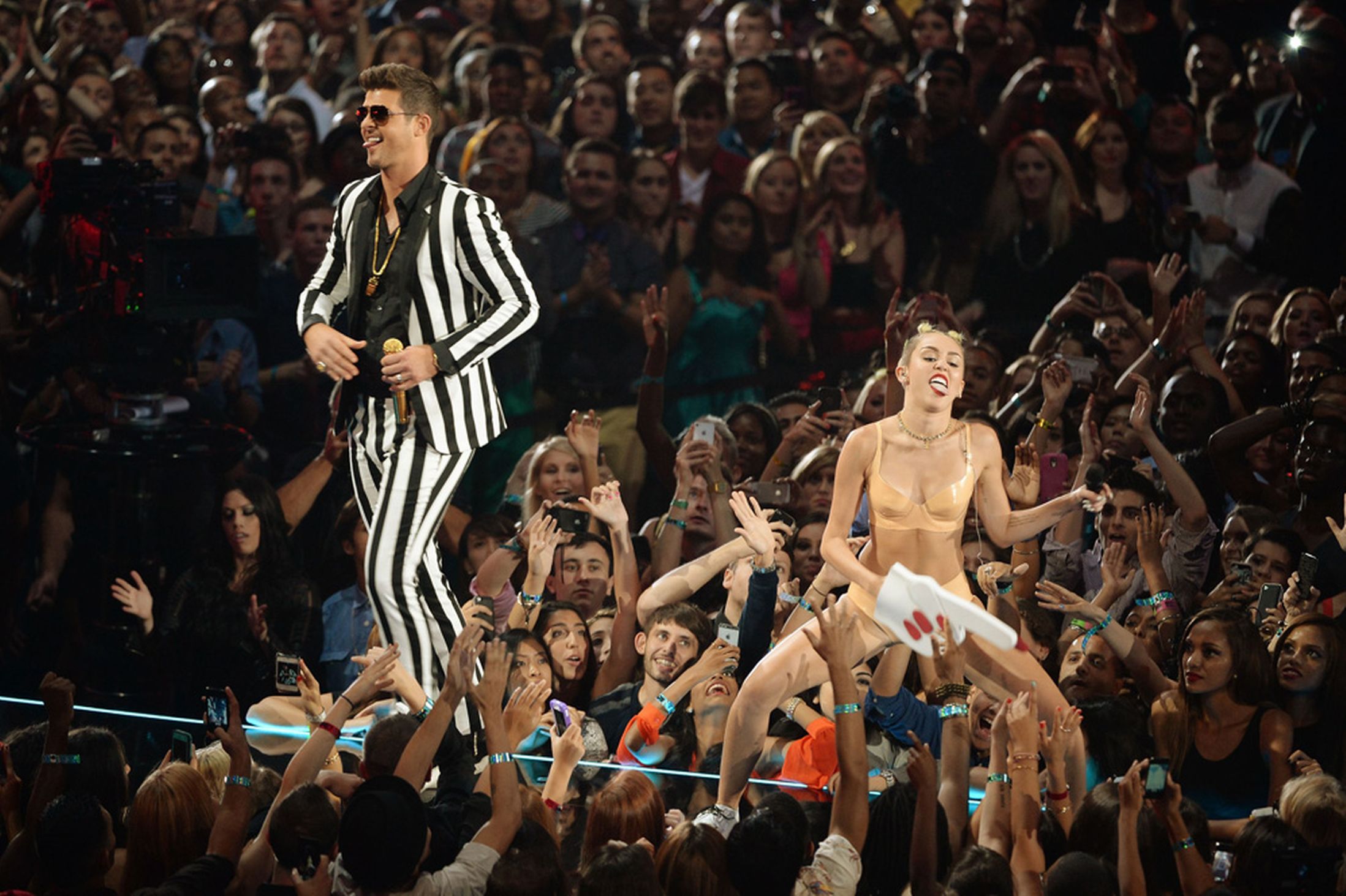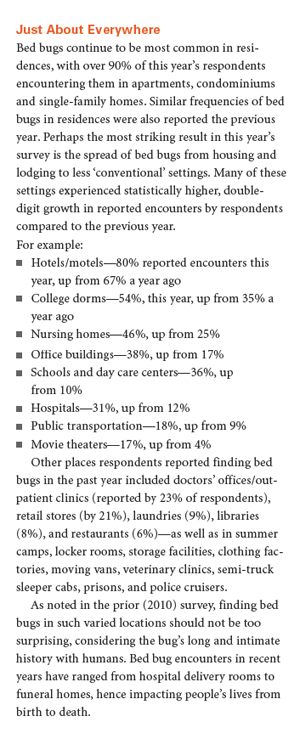“I don’t pay attention to the negative. Because I…I’ve seen this play out so many…how many times have we seen this play out in pop music? You know now. You know what’s happening. Madonna’s done it. Britney’s done it. Every VMA performance, anyone who perform — you know, anyone who performs. That’s what you’re looking for. You’re wanting to make history. Me and Robin [Thicke] the whole time said, ‘You know we’re out to make history right now.'” — Miley Cyrus, her first post-Video Music Awards interview on MTV News.
On August 28, 2013, I fired up my browser on the 50th anniversary of Martin Luther King delivering his “I Have a Dream” speech. I was appalled. I was glad to see King recognized in a Google Doodle, but why were King’s words reduced to mere text? On January 16th, Google had celebrated Frank Zamboni’s 112th birthday with a game that allowed you to maneuver through an ice rink. On Valentine’s Day, you could click on a heart to rotate two Ferris Wheels. On February 19th, Copernicus’s 540th birthday was recognized with a slowly animated solar system. On June 10th, there had been an elaborate Maurice Sendak Doodle. Even Debussy’s 151st birthday ushered in an impressive animation set to “Clair de Lune.”
If the mainstream baseline of online culture could not be bothered to offer more than a perfunctory nod to King, what was the point in celebrating?
Days before, the Internet had been aflame with Miley Cyrus’s disastrous twerking at the MTV Video Music Awards. Beyond the trashy bombast, people were bothered by the cultural appropriation, with some commentators comparing the performance to a minstrel show. One of the smartest and most heartbreaking responses came from Tressie McMillan Cottom, who described one summer in which she and her then partner had been the only black couple during happy hour. White men and women approached Cottom with racist suggestions. She wrote about how the dancers behind Miley Cyrus fit into a wretched history of black female bodies as “production units.” She pointed out how “Cyrus might be the most visible to our cultural denigration of bodies like mine as inferior, non-threatening spaces where white women can play at being ‘dirty’ without risking her sexual appeal.”
I had thought that white culture’s worst impulses could be curbed for a day with a dignified celebration of a man who, unlike Miley Cyrus, made history for the right reasons. Wasn’t King worth more than a static image or a token acknowledgment? Even with the expensive rights attached to the speech, couldn’t Google, estimated to be worth more than $200 billion, have kicked in a few clams to use the audio in its Doodle? Why had white culture silenced one of black culture’s most indelible icons fifty years after the fact? Wasn’t King worth more than a Zamboni?
Lindy West has spent the past few years establishing herself as an outspoken pundit on rape jokes and comedy with Jezebel posts such as “Hey, Men, I’m Funnier Than You” and “How to Make a Rape Joke.” She was invited to appear on the May 30, 2013 episode of Totally Biased with W. Kamau Bell to discuss her views further with Jim Norton. She suffered abusive fallout.
But white culture overlooked one vital element of this regrettable chapter. West did not appear on The View or The Colbert Report, but a television show hosted by an African-American, a show that also happened to be a smart and entertaining corrective to The Daily Show‘s predominantly Caucasian concerns. The show often discussed issues pertaining to race. What’s striking about West’s exchange with Bell is how she adopted a pugnacious tone towards the amicable host from the beginning:
Bell: And so I’ll ask the same question to you, Lindy. Do you think comics should say anything they want without consequences?
West: Uh, well, first of all, I think that question is dumb.
Bell: Thank you. Thank you very much.
[STUDIO AUDIENCE LAUGHTER]
West: Because…
Bell: (nodding his head up and down) Good start for me. This is feminist versus comic, not this comic [pointing to self]. Over there. [pointing to Jim Norton]
West: So sorry. Um, no, because, uh, everything has repercussions. So if you’re talking about legal repercussions, uh, yeah, I do not think that comedy should be censored. And we’re not here to talk about censorship. And I’m pretty sure we agree. Uh, what I’m talking about is the kind of repercussion where you choose to say something that, like, traumatizes a person who’s already been victimized and then I choose to call you a dick. And that’s the repercussion.
Bell asked a perfectly reasonable question for his television audience, many composed of African-Americans who may not have been acquainted with Jezebel, so that everyone could understand West’s position. What was West’s response? “I think that question is dumb.” She then asserted her privilege by stating that she had the right to call anyone a dick as a free speech repercussion.
On June 4, 2013, Lindy West posted a video and a blog post, in which West read a series of terrible threats that she received in response to her Totally Biased appearance. (The only reason the video hasn’t been embedded in this essay is because Jezebel hasn’t allowed it to be embedded at any other site, cheapening West’s response into pageviews and linkbait.)
The abuse directed West’s way was absolutely unacceptable. It revealed awful misogyny that will take a long time to shake from the American fabric. But this shouldn’t disavow West of her free speech position, which involves another person offering “repercussions” in response to a disagreeable position. Clearly, the people who fired off bilious invective took West up on her offer. The difference here is that West has painted herself, with considerable justification, as the victim. Nevertheless, in her post, West informed her readers who the “correct” people were to abuse. Of Jim Norton, West wrote that he had been “kind and thoughtful throughout this whole thing, so don’t be mean to him.” When comedians, who were understandably ired by West’s politically correct position, expressed umbrage, they too were implicated:
Local comics — whom I know and work with — have told me to shut the fuck up. One hopes I’ll fall down a flight of stairs. (He later apologized—to my boyfriend, not me.)
In other words, West was unwilling to hold herself responsible for her own remarks — which includes telling one of the classiest African-American hosts on television that his question was “dumb” — while simultaneously placing herself in an entitled position in which she was shielded from criticism. She could condemn standup comics who fired off rape jokes, but refused to consider the consequences of her own remarks or biases. (This behavior is quite similar to what Richard H. Cooper observed of Twitter celebrities in 2012, pointing to hierarchies in which the top tier “[dispenses] admonishments to proles who get impudent” while simultaneously avoiding introspection.)
On June 6, 2013, Bell aired a followup segment about the discussion (and its aftermath):
Bell: Thousands of men protested Lindy’s claim that rape jokes encourage a culture of violence against women. And how did they do that? By flooding her inbox with threats of violence against women. Yay! Men! We’re the worst! Come on, men, what are we doing? I feel gross being a part of a group this terrible. Is this what it’s like to be white?…Now people are saying that Lindy is against free speech. She’s not. She wasn’t even arguing against rape jokes. She was arguing against what many of you asshats are doing right now to her. Attempting to silence a woman by using threats and intimidation. Now maybe that point got lost somewhere in the debate. Personally I blame the moderator….All I’m really saying is that this Internet harassment has got to stop. And that’s why I’ve developed the new technology that will put an end to hate speech on the Internet. You guys have heard of CAPTCHA? You know, when you fill in stuff on the Internet? Yeah. Well, I’ve developed SHUTCHA. As in Shutcha Damn Mouth! Exactly. Yes. Basically, before you can send me any tweets, you have to fill out this SHUTCHA to prove that you have basic awareness of black people and black culture. For example, is this word spelled correctly? [“NIGER” flashed on screen.] If your answer is “no,” then I won’t be hearing from you and you’ll have to harass a local black in your area.
Bell’s SHUTCHA joke brilliantly pinpointed the problem with white culture: namely, its willful ignorance of black people and black culture. (This is also seen with such needless concomitant terms as “Black Twitter,” a catchall designate used by clueless white people to casually position African-American voices as some Other to be deprioritized and/or ignored). But because Bell had been put on the spot and was forced to stand up for Lindy West, he was unable to remark on the more severe problem of white culture’s appropriation of other cultures — what Kiese Laymon has referred to as “the worst of white folks”:
The worst of white folks, I understood, wasn’t some gang of rabid white people in crisp pillowcases and shaved heads. The worst of white folks was a pathetic, powerful “it.” It conveniently forgot that it came to this country on a boat, then reacted violently when anything or anyone suggested it share. The worst of white folks wanted our mamas and grandmas to work themselves sick for a tiny sliver of an American pie it needed to believe it had made from scratch. It was all at once crazy-making and quick to violently discipline us for acting crazy. It had an insatiable appetite for virtuoso black performance and routine black suffering. The worst of white folks really believed that the height of black and brown aspiration should be emulation of its mediocre self. The worst of white folks inherited disproportionate access to quality health care, food, wealth, fair trials, fair sentencing, college admittance, college graduations, promotions and second chances, yet still terrorized and shamed other Americans who lacked adequate access to healthy choices at all. White Americans were wholly responsible for the worst of white folks, though they would do all they could to make sure it never wholly defined them.
In other words, white culture believes that black people should emulate the very mediocrity that now forms its nostalgia-soaked identity. W. Kamau Bell is not permitted to push back at Lindy West without “repercussions,” but he is allowed to emulate her unexceptional intellectual position (“She wasn’t even arguing against rape jokes. She was arguing against what many of you asshats are doing right now to her. Attempting to silence a woman by using threats and intimidation.”) instead of expanding his shrewder and more sophisticated observations on male abuse and the racial dynamics of expression. Robin Thicke is free to rip off Marvin Gaye’s “Got to Give It Up” and turn it into one of this summer’s greatest hits (“Blurred Lines”) and, because he too represents the worst of white culture, he audaciously files a preemptive lawsuit against Gaye’s family to prevent them from seeking damages against Thicke’s pellucid appropriation, claiming, “Plaintiffs, who have the utmost respect for and admiration of Marvin Gaye, Funkadelic and their musical legacies, reluctantly file this action in the face of multiple adverse claims from alleged successors in interest to those artists.”
In August, white feminist culture was challenged by Mikki Kendall with the Twitter hashtag #SolidarityIsForWhiteWomen, largely in response to the now disgraced Hugo Schwyzer:
It appeared that these feminists were, once again, dismissing women of color (WOC) in favor of a brand of solidarity that centers on the safety and comfort of white women. For it to be at the expense of people who were doing the same work was exceptionally aggravating.
The sole Jezebel blog post on the hashtag is a collection of the best tweets rather than bona-fide intellectual jostling with this very serious grievance. There is also this condescending note at the bottom of the post:
Update: The originator of the hashtag page, Mikki Kendall, has been incredibly influential to this conversation and should have been at the top of this list. See her speak more on the hashtag here. To have not included her in the original post was an oversight. Apologies to Ms. Kendall.
This apology isn’t enough. Because without real commitment to thinking and true acknowledgment of one’s blind spots, there can be neither influence nor meaningful conversation. There can be only white culture, inured from disagreement, that monopolizes the dais and remarks upon black culture with a flip elitist tone that would be offensively facile if it weren’t so damn risible:
Moscato: The Gateway Wine For People Of Color? http://t.co/8SjiZeaQEw
— NPR News (@nprnews) June 27, 2013
White culture doesn’t just want to plunder the best of black folks for callow entertainment. It wants to ensure that black culture is never explicitly identified as black. It wishes to soften any sharp edges. It wishes to promulgate endless articles that, as the podcast The Black Guy Who Tips recently put it, fuck with black people. The disgraceful imbalance of free expression identified by Stokely Carmichael in 1966 is still essentially the same: “the only acts that white people can do is to stop denying black people their freedom; that is, they must stop denying freedom. They never give it to anyone.”
This is far more insidious than white culture’s mere copycat relationship with black culture, observed by Norman Mailer in the Fall 1957 issue of Dissent. White culture has moved beyond the willful scavenging and sanding of black culture’s best bits because it feels that it must hog the spotlight. White culture is terrified of engagement. In a complicated world of turmoil, white culture continues to cleave to a new political privilege, in which there can be no room for hyperbole, extremist rhetoric, and what Jon Stewart has wrongly identified as “insanity.” There is no space within white culture to cultivate independent, original, provocative, and non-ideological inquiry. But there is relentless racial assumption, limitless listicles, time-eating timidity through hate-favoriting and subtweets on Twitter, and dull depositories for white culture fantasies such as NPR, The Awl, Slate, McSweeney’s, and Jezebel.
White culture is never about taking a step back and allowing another culture to express itself. It is driven by an intuitive imperialism, one that it can scarcely recognize, that involves blaring its own cultural standards through a megaphone manufactured in another century. Indeed, white culture’s most prolific literary spokesperson, Joyce Carol Oates, is not immune from such xenophobic disgrace. Earlier this year, when she remarked upon the complicated political situation in Egypt:
Where 99.3% of women report having been sexually harassed & rape is epidemic–Egypt–natural to inquire: what's the predominant religion?
— Joyce Carol Oates (@JoyceCarolOates) July 5, 2013
Ironically, many of these sentiments led Jezebel‘s Katie J.M. Baker to urge Oates to stop tweeting. Was a 75-year-old writer revealing the worst of white folks? How long would this be tolerated from the Establishment?
Not long, as it turned out. On Sunday, The New York Times published a satirical essay by Teddy Wayne upholding the the same white culture stereotypes that Miley Cyrus had sought to “make history” with:
Explain that twerking is a dance move typically associated with lower-income African-American women that involves the rapid gyration of the hips in a fashion that prominently exhibits the elasticity of the gluteal musculature.
Some of white culture swallowed this up without batting an eye:
Explaining Twerking to Your Parents, via @nytimes What a hoot – nicely done Teddy Wayne! http://t.co/8CmSLQFexo
— Candi Deal (@CandyceDeal) September 2, 2013
Deliciously cheeky column by Teddy Wayne in NYT today. Parents and teens? For you: http://t.co/roK2bgfz6h
— Erin Waite (@ErinWaite42) September 2, 2013
But a new and hilarious hashtag, #askteddywayne, started making the rounds on Twitter, fighting back against Wayne’s McSweeney’s-style essay with humorous qualities that had eluded the ostensibly professional writer:
There was no twerking featured in Roots. Was that movie historically inaccurate? #askteddywayne @TeddyWayne1999
— Scary Magdalene (@WontDoRite) September 2, 2013
I'm only half black. Should I just twerk one cheek at a time? #askteddywayne @TeddyWayne1999 @brokeymcpoverty
— Asia Lavarello (@AsiaPoetisa) September 2, 2013
Will applying for welfare make a woman twerk better? #askteddywayne @TeddyWayne1999
— Jacob (@Just_JDreaming) September 2, 2013
I hold degrees from two prestigious universities yet can't say no to McDonald's sweet tea & Popeyes chicken. Please advise. #askteddywayne
— Ignant Intellectual® (@ignantintellect) September 2, 2013
So when white people twerk it's considered being rebellious, but when black people twerk we're just being poor? #AskTeddyWayne
— SayNah Lathan (@drugfreekeisha) September 2, 2013
Teddy Wayne sent apologies to some of his detractors in private. But as of Wednesday afternoon, he has not offered a public apology. He has switched his Twitter account from public to private.
White culture has been slow to recognize and atone for Teddy Wayne’s essay. The only outlets that have covered this scrape at length are The Root, The Inquisitor, Galleycat, and The Nation. Even more astonishing, New York Times public editor Margaret Sullivan expressed her enthusiasm that Wayne’s piece was #2 on the New York Times‘s most emailed list, without appearing to comprehend why (other than that it was “funny”):
Explaining Twerking to Your Parents http://t.co/jYxHQXKEMP (I love that this funny piece is #2 on the @nytimes most emailed list)
— Margaret Sullivan (@Sulliview) September 2, 2013
Perhaps Miley Cyrus, Robin Thicke, Teddy Wayne, some of the people who write for Jezebel, the editor at The New York Times who allowed Wayne’s piece to run, and the people behind the Google Doodles really don’t comprehend how their responses and appropriation of black culture represent Laymon’s “worst of white folks.” They have seen the battles play out. They are familiar with some unspecified pattern, much as those who listen to a radio program in the background without really listening to it are dimly aware that there is something important being communicated. But they cannot engage with black culture. Like Cyrus, they won’t “pay attention to the negative.” Because to do so would be to confess to their own mediocrity. To do so with grace and candor would be to share the stage. To find true humility and humanity. To learn something.
White culture has had a very long run. But the time has come for those who make it and comment on it to understand that there is more to appropriating culture than the great white lie of “respect and admiration.”






